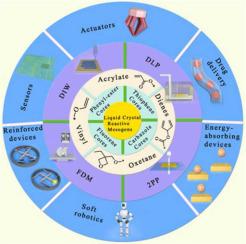Additive Manufacturing ( IF 10.3 ) Pub Date : 2022-05-06 , DOI: 10.1016/j.addma.2022.102861 Guang Hu 1 , Biao Zhang 2 , Stephen M Kelly 3 , Jingjing Cui 2 , Kailong Zhang 1 , Weiwei Hu 1 , Dandan Min 1 , Shijie Ding 1 , Wei Huang 2

|
Liquid crystals are often regard as a fourth state phase of matter alongside solids, liquids and gases. It has been estimated that one out of every ten new synthetic compounds is a liquid crystal, mainly due to the fact that liquid crystals have been used in Liquid Crystalline Displays (LCDs) for over 50 years. Liquid crystals, often referred to as mesogens, exhibit an unique range of ordered mesophases with anisotropic physical properties, such as optical, magnetic and dielectric anisotropy, for example. These highly anisotropic properties and the ability of liquid crystals to self-organize on surfaces, has led to them being, are used in a wide range of non-LCD applications. These applications include photochromics, pressure sensitive paints, optical retarders and optical compensation films, etc. Highly crosslinked, anisotropic polymer networks, derived from photopolymerisable liquid crystals, so-called reactive mesogens (RMs), have enabled solution-fabricated organic light-emitting diodes (OLEDs), organic field-effect transistors (OFETs) and organic photovoltaic devices (OPVs) for plastic electronics. This review will be focus on the relatively recent application of liquid crystals, i.e., the 3D/4D printing of reactive mesogens and subsequent polymerization to form anisotropic polymer networks in advanced additive manufacturing applications. It will highlight the challenges of the synthesis and use of new liquid crystalline materials in 3D/4D printing for additive manufacturing applications. It will show how the study of the successful development of design strategies for the synthesis of novel liquid crystals for flat panel displays is inspiring the development of novel photopolymerisable liquid crystals for additive manufacturing. It is intended that this review will serve to inspire chemists, with little or no knowledge of liquid crystals, or liquid crystal chemists, to design and synthesize new liquid crystals for 3D/4D printing.
中文翻译:

用于增材制造的光聚合液晶
液晶通常被视为与固体、液体和气体一样的物质的第四态相。据估计,十分之一的新合成化合物是液晶,这主要是由于液晶已在液晶显示器 (LCD) 中使用了 50 多年。液晶,通常被称为介晶,表现出独特的有序中间相范围,具有各向异性的物理特性,例如光学、磁性和介电各向异性。这些高度各向异性的特性和液晶在表面上自组织的能力导致它们被广泛用于非 LCD 应用。这些应用包括光致变色、压敏涂料、光学延迟器和光学补偿膜等。高度交联的各向异性聚合物网络,衍生自可光聚合液晶,即所谓的反应性液晶元 (RM),已经使溶液制造的有机发光二极管 (OLED)、有机场效应晶体管 (OFET) 和有机光伏器件 (OPV) 用于塑料电子产品。本综述将重点关注液晶的相对较新的应用,即反应性介晶的 3D/4D 打印和随后的聚合,以在先进的增材制造应用中形成各向异性聚合物网络。它将突出在 3D/4D 打印中用于增材制造应用的新型液晶材料的合成和使用所面临的挑战。它将展示成功开发用于平板显示器的新型液晶合成设计策略的研究如何激发用于增材制造的新型光聚合液晶的开发。这篇综述旨在激发对液晶知之甚少或完全不了解的化学家或液晶化学家设计和合成用于 3D/4D 打印的新液晶。
















































 京公网安备 11010802027423号
京公网安备 11010802027423号